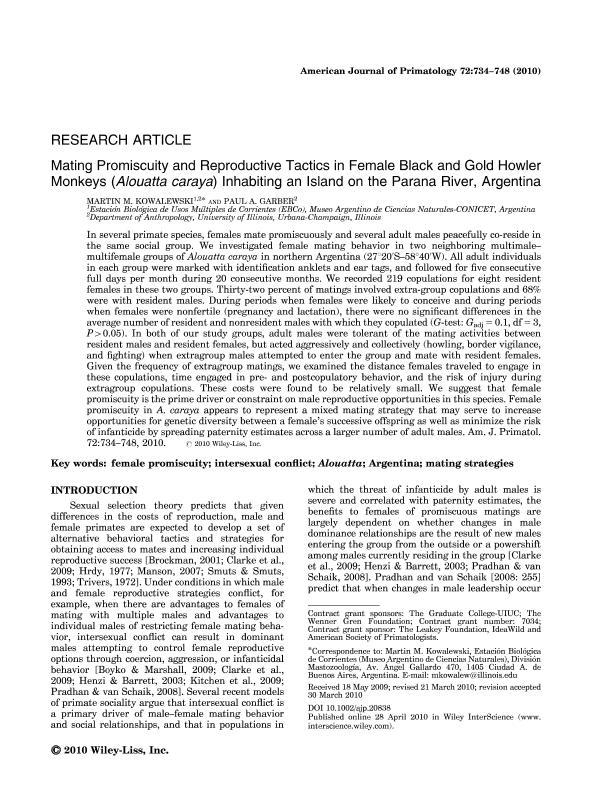Mostrar el registro sencillo del ítem
dc.contributor.author
Kowalewski, Miguel Martin

dc.contributor.author
Garber, Paul A.
dc.date.available
2017-05-09T18:38:03Z
dc.date.issued
2010-08
dc.identifier.citation
Kowalewski, Miguel Martin; Garber, Paul A.; Mating promiscuity and reproductive tactics in female black and gold howler monkeys (Alouatta Caraya) inhabiting an island on the Paraná river, Argentina; Wiley-liss, Div John Wiley & Sons Inc; American Journal Of Primatology; 72; 8; 8-2010; 734-748
dc.identifier.issn
0275-2565
dc.identifier.uri
http://hdl.handle.net/11336/16157
dc.description.abstract
In several primate species, females mate promiscuously and several adult males peacefully co-reside in the same social group. We investigated female mating behavior in two neighboring multimale–multifemale groups of Alouatta caraya in northern Argentina (27°20′S–58°40′W). All adult individuals in each group were marked with identification anklets and ear tags, and followed for five consecutive full days per month during 20 consecutive months. We recorded 219 copulations for eight resident females in these two groups. Thirty-two percent of matings involved extra-group copulations and 68% were with resident males. During periods when females were likely to conceive and during periods when females were nonfertile (pregnancy and lactation), there were no significant differences in the average number of resident and nonresident males with which they copulated (G-test: Gadj=0.1, df=3, P>0.05). In both of our study groups, adult males were tolerant of the mating activities between resident males and resident females, but acted aggressively and collectively (howling, border vigilance, and fighting) when extragroup males attempted to enter the group and mate with resident females. Given the frequency of extragroup matings, we examined the distance females traveled to engage in these copulations, time engaged in pre- and postcopulatory behavior, and the risk of injury during extragroup copulations. These costs were found to be relatively small. We suggest that female promiscuity is the prime driver or constraint on male reproductive opportunities in this species. Female promiscuity in A. caraya appears to represent a mixed mating strategy that may serve to increase opportunities for genetic diversity between a female's successive offspring as well as minimize the risk of infanticide by spreading paternity estimates across a larger number of adult males.
dc.format
application/pdf
dc.language.iso
eng
dc.publisher
Wiley-liss, Div John Wiley & Sons Inc

dc.rights
info:eu-repo/semantics/openAccess
dc.rights.uri
https://creativecommons.org/licenses/by-nc-sa/2.5/ar/
dc.subject
Female Promiscuity
dc.subject
Intersexual Conflict
dc.subject
Mating Strategies
dc.subject
Alouatta Caraya
dc.subject.classification
Ecología

dc.subject.classification
Ciencias Biológicas

dc.subject.classification
CIENCIAS NATURALES Y EXACTAS

dc.title
Mating promiscuity and reproductive tactics in female black and gold howler monkeys (Alouatta Caraya) inhabiting an island on the Paraná river, Argentina
dc.type
info:eu-repo/semantics/article
dc.type
info:ar-repo/semantics/artículo
dc.type
info:eu-repo/semantics/publishedVersion
dc.date.updated
2017-04-25T13:26:49Z
dc.journal.volume
72
dc.journal.number
8
dc.journal.pagination
734-748
dc.journal.pais
Estados Unidos

dc.description.fil
Fil: Kowalewski, Miguel Martin. Consejo Nacional de Investigaciones Científicas y Técnicas. Oficina de Coordinación Administrativa Parque Centenario. Museo Argentino de Ciencias Naturales "Bernardino Rivadavia". Est. Biológica de Usos Multiples (sede Corrientes); Argentina. University Of Illinois; Estados Unidos
dc.description.fil
Fil: Garber, Paul A.. University Of Illinois; Estados Unidos
dc.journal.title
American Journal Of Primatology

dc.relation.alternativeid
info:eu-repo/semantics/altIdentifier/doi/http://dx.doi.org/10.1002/ajp.20838
dc.relation.alternativeid
info:eu-repo/semantics/altIdentifier/url/http://onlinelibrary.wiley.com/doi/10.1002/ajp.20838/abstract
Archivos asociados
